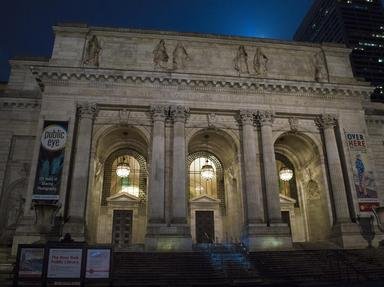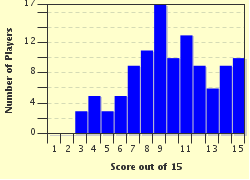Quiz Answer Key and Fun Facts
1. While Arthur Miller's "Death of a Salesman" won him the 1949 Pulitzer Prize for Drama, another play of his has been produced more frequently. In 1953, Miller published this play that, through allegory, criticized the United States' "witch hunt" for American communists. In 1956, the House Un-American Activities Committee subpoenaed him for questioning. What is the name of this controversial play?
2. Born in Jackson, Mississippi, in 1909, this American writer achieved early recognition as a photographer for the Works Progress Administration (WPA). Many of her photos of local Mississippians are collected in her 1971 book "One Time and Place". However, her fiction is what would establish her lasting significance through novels like "The Optimist's Daughter", which won the 1973 Pulitzer Prize for Fiction, and short stories like "Why I Live at the P.O." Who is this author?
3. After being expelled from Columbia University for sketching obscenities in the dust on his dormitory window, Allen Ginsberg lived periodically with William Burroughs and Jack Kerouac when he wasn't working as a messman onboard merchant tankers. Later, he spent eight months in the Columbia Psychiatric Institute to avoid jail time for allowing an acquaintance to stash stolen goods in his apartment. From these experiences he would compose one of the most influential poetic works of the twentieth century. In fact, the night he read the poem aloud at the Six Gallery reading in San Francisco is considered "the birth trauma of the Beat Generation". What poem is this?
4. At the age of fourteen, this American writer became a junior minister at the Fireside Pentecostal Assembly in Harlem, but by seventeen he had abandoned the church as well as Christianity. Nevertheless, his success at preaching would have an influence on his narrative style, which captured the rhythm of spoken prose while he told the stories of blacks and homosexuals struggling to live in an oppressive society. Who is this author of such novels as "Go Tell It on the Mountain" (1953), "Giovanni's Room" (1955), and "Another Country" (1962)?
5. Gifted at drawing and caricature, this individual spent a year in England studying art after he graduated summa cum laude from Harvard University in 1954. However, when he returned to the States and began work at "The New Yorker", he gradually switched from drawing to writing. He is perhaps most celebrated for a series of novels about the life of Harry Angstrom: "Rabbit, Run", "Rabbit Redux", "Rabbit Is Rich", and "Rabbit at Rest". Who is this American author who won two Pulitzer Prizes for Fiction during his lifetime?
6. This American poet became interested in poetry at the age of twenty-eight after seeing the critic I. A. Richards lecture about sonnets on television. Her first book of poems--"To Bedlam and Part Way Back"--was published in 1960 and focused on her struggle with mental illness, her consequent stay in a mental hospital, and her attempts at reconciliation with her husband and daughter following her release. Who is this poet who chronicled her struggles with depression, suicide, and death in other books, such as 1966's "Live or Die", which won a Pulitzer Prize for Poetry?
7. Deliberately avoiding recognition and celebrity, this American writer's history, personal life, and residence remain mostly a mystery, and most of the few photographs of him in circulation are of his high school, college, and United States Navy years. From 1963 to 1973, he published three novels--"V.", "The Crying of Lot 49", and "Gravity's Rainbow"--and then, except for a collection of earlier short stories that was published in 1984, no other books emerged until 1990's "Vineland", after which a small number of novels has followed. Who is this American author celebrated for his postmodern style, which is obviously influenced by classical and high literature as well as by popular and low culture (i.e. comic books)?
8. Born in Eatonton, Georgia, in 1944, this American author grew up in rural poverty. When still a little girl, she was shot in one of her eyes with a BB gun fired by her brother, and the resulting disfigurment plagued her until she had corrective surgery during her teenage years. Her first novel--"The Third Life of Grange Copeland"--was published in 1970, but her most well known is her third novel, "The Color Purple", which won the Pulitzer Prize for Fiction in 1983. Who is this writer?
9. Born in Chicago in 1954, the child of a Mexican father and a Mexican-American mother, this writer has accomplished much for Hispanic, feminist, and Chicana societies in the United States. Who is this American author whose Mexican-pink house created controversy by challenging the community covenant within the monocultural district in which she lived in San Antonio, Texas, and whose notable works include her 1984 novel "The House on Mango Street" and her 1991 short story collection "Woman Hollering Creek"?
10. Published in 1959, this American writer's poetry collection "Life Studies" challenged the more traditional style of writing poetry through its less symbolic, more straight-forward style of writing as well as through its candid confessional style. For example, one of the poems--"Memories of West Street and Lepke"--tells of the poet's complacent and indulgent lifestyle years after his serving time in prison for being a conscientious objector to the United States' involvement in World War II. Who is this poet who was related to two earlier American poets who shared his last name?
11. Born in Savanah, Georgia, and living a great number of her years in Milledgeville, Georgia, this American writer is well known for her short stories that incoporate dark comedy with violent endings, that nondidactically allude to and parody her Catholic faith, and that cause readers to experience a strange mixture of sympathy and scorn for characters who have faulty world views. Who is this author of stories like "Good Country People", in which the main character has her prosthetic leg stolen by a con man who pretends to be a Christian Bible salesman?
12. Amy Tan has remained both a popular and critically-acclaimed writer since the publication of her first novel in 1989, "The Joy Luck Club", which also became the inspiration for a film as well as a play. Since that time, she has continued to publish many other moving and artfully composed novels. Which of the following titles is NOT the name of one of her novels?
13. This American began writing poetry at the age of seven and began compiling it in notebooks at the age of eleven. In 1950, her 1949 book of poems "Annie Allen" won the Pulitzer Prize for poetry, thus making her the first African American woman to win it. Who is this author of such poems as "mother", "The Bean Eaters", and "We Real Cool"?
14. While the American author Tim O'Brien has written a number of different novels, he is often associated with writing from the soldier's perspective about America's involvement in the Vietnam War. Drafted by the United States military after he graduated from Macalester College, O'Brien himself served during the war and earned the rank of Sergeant. Which of the following novels written by O'Brien is NOT about the Vietnam War?
15. A small number of American writers have received the rare honor of winning the Nobel Prize for Literature during the award's existence in the twentieth and twenty-first centuries. Which writer among those listed below did NOT win the Nobel Prize in Literature?
Source: Author
alaspooryoric
This quiz was reviewed by FunTrivia editor
looney_tunes before going online.
Any errors found in FunTrivia content are routinely corrected through our feedback system.

